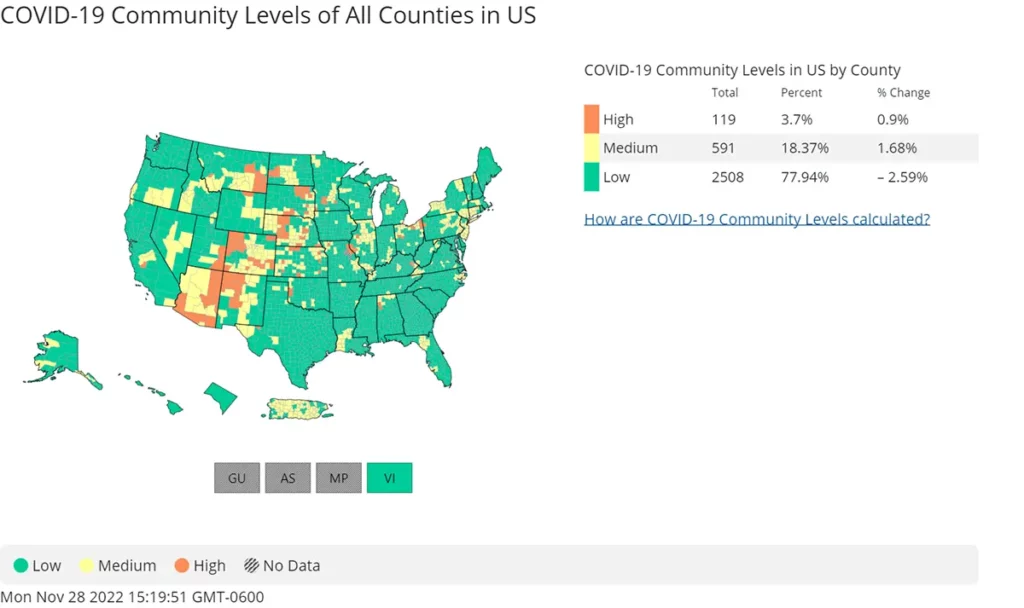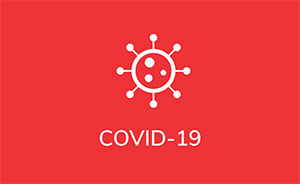Here is your weekly summary of what has been happening this past week in the United States. Keep in mind, data is always going to be delayed/underreported when there is a holiday weekend due to government offices being closed. But we are still going to provide the latest information available to us.
Weekly COVID-19 Statistics
The CDC’s map of community level of spread updated as of November 20th, indicates 22.07% of the US population lives in an area with medium to high transmission rates. This is a 2.59% increase from the week prior. Remember that this data point is calculated by the CDC based on weighting the number of hospitalizations in a community, not case rates. See the COVID-19 update from last week for a more detailed explanation.

The COVID-19 Wastewater Monitoring Project measures the level of the SARS-CoV-2 virus concentration present in wastewater samples taken from across the United States. The data updated on November 23rd indicates a significant increase over last week (the top darker blue line) compared to the number of actual reported positive case numbers. This will be something to keep an eye on, as increased wastewater amounts typically won’t be reflected in reported case numbers for several more weeks. Wastewater data is a good early detection tool to anticipate what may follow.

The rate of hospitalizations last updated on November 26th indicate hospitalizations have trended down slightly. This is in comparison to the 7-day average two weeks ago for the week of November 19th, which is delayed due to the reporting constraints of the holiday weekend. Note that when hospitalizations are broken down into age groups (as pictured in the graph on the right) those over the age of 70 continue to have a significantly higher hospitalization rate compared to all other age groups.

The weekly average number of COVID-19 deaths in the US ending the week of November 23rd were 2,644. This is an increase of 422 deaths from the week prior.

Current & Emerging Variants of Concern (VOC)
BQ.1 and BQ.1.1 is still showing a significant growth advantage over BA.5 and all of the other circulating variants, which is very concerning for those who are immunocompromised (including everyone diagnosed with CLL / SLL regardless of treatment status). This is because these two dominant variants (BQ.1 and BQ.1.1) are resistant to both Evusheld and Bebtelovimab.
Two new variants, BF.11 and XBB appeared on the variant tracker this week. There are no preliminary data available yet on BF.11 regarding resistance to monoclonal antibodies, but there are preliminary data indicating XBB will be resistant to both Evusheld and Bebtelovimab. XBB is thought to be one of the most immune evasive variants yet. It was responsible for a large surge of cases in Singapore during the month of October and will be one to watch, as it made the news for growing rapidly from 22% of cases to a whopping 54% in just one week’s time, and was responsible for a large number of reinfections there due to its keen ability to evade any natural immunity individuals had developed from prior infections. Here is the overall breakdown of variants in the US as of November 26th.
Here is a summary of what we know about the current variants of concern and how they hold up against Evusheld and Bebtelovimab as of the time this update was written:
Data indicate that Bebtelovimab will no longer be effective against the following variants:
- BQ.1
- BQ.1.1
- XBB (new this week)
These three variants together made up 60.4% of cases nationwide as of November 26th.
Data indicate that Evusheld will no longer be effective against the following variants:
- BA.4.6
- BA.2.75.2
- BQ.1
- BQ.1.1
- BF.7
- BN.1
- BA.5.2.6
- XBB (new this week)
These eight variants together made up over 76.2% of cases on average nationwide as of November 26th.
It is important to note that both Evusheld and Bebtelovimab are STILL EFFECTIVE against a few of the minor variants including BA.5 (19.4% of cases), against BA.2 (0.8% of cases), and BA.2.75 (2.6% of cases). Preliminary data indicate that both of the remaining COVID-19 monoclonal antibodies (CmAbs) may retain activity against BN.1 (2.9% of cases), and BF.7 (7.0% of cases), although this is yet to be confirmed.
Remember, there are significant regional differences in the percentage (or prevalence) of all variants of concern. So, it is of utmost importance right now to keep an eye on the percentage of variants in your region by watching the breakdown that is updated every Friday on the CDC’s regional variant tracker.
The above map shows the percentage of BA.5 by region. This is relevant because BA.5 is the main variant left standing that is not resistant to Evusheld. Last week, we urged caution to those particularly located in the New York state region, the southern United States, and the west coast. However, we now want to urge our entire community to act as if Evusheld is no longer providing you any protection at all. This is because as of last week when the numbers were last reported, Evusheld worked best within the Midwest, but this was still only against a meager 37.4% of cases. And remember, the variant data are lagging by about a week due to the time it takes to gather the information and put out the report, so we can expect those percentages to be even lower by now. CLL Society is still waiting on a formal announcement to come from the FDA on Evusheld and Bebtelovimab. Until that time, please discuss any questions you might have surrounding the CmAbs with your healthcare provider.
Paxlovid and Remdesivir are still very effective antivirals that are holding up well against all variants of concern. However, it is absolutely key to get tested early and often if you have known exposure to someone who is infected or are exhibiting symptoms as an immunocompromised individual (preferably obtain a PCR test). This is because Paxlovid must be started orally within five days of symptom onset and Remdesivir must be started intravenously within seven days of symptom onset. And please remember to notify your healthcare provider as soon as you test positive so that they can more quickly arrange for you to obtain antiviral therapy as appropriate.
COVID-19 in the News
As mentioned in previous weekly updates, experts agree that COVID-19 case numbers are underreported by as much as 4-5 times due to the wide availability of at home tests. Last week, the NIH launched a campaign called “Make My Test Count” which aims to help public health teams have a more accurate picture of how much COVID-19 is actually spreading in communities. It provides an anonymous portal where anyone can self-report either a positive and negative test result (reporting negative tests are important too). That deidentified information is sent to the same public health systems that currently receive COVID-19 test results from laboratories and doctors’ offices.
A study performed by MIT and published in the Journal of the Royal Society Interface, reported that maintaining an indoor relative humidity between 40-60% is associated with relatively lower rates of COVID-19 infection, while indoor conditions outside of this range are associated with worse outcomes. So having a humidifier in your home is another thing to consider as a possible preventative tool, especially during the winter months when the air is extremely dry.
In Summary
CLL Society will continue to stress this over and over again to our community: Please mask up 100% of the time when you are going to be in the presence of others outside of your household right now, and make sure to do all the things we learned were important earlier in the pandemic! Remember, you can obtain quality N95 masks free of charge from many local pharmacies across the country.
Please revisit your COVID-19 Action Plan. In addition to masking, we would be remiss in each of these updates if we did not mention the importance of going back to the basics of infection control. So, practice good hand hygiene, do all you can to ensure there is good air-flow/ventilation whenever you are around others indoors (especially those who are unmasked), make sure you have received your bivalent COVID-19 booster (encourage those around you to do the same if appropriate), and practice social distancing/avoid indoor gatherings as much as possible.
Keep learning and stay well.
Robyn Brumble, MSN, RN
Director of Scientific Affairs & Research
CLL Society



